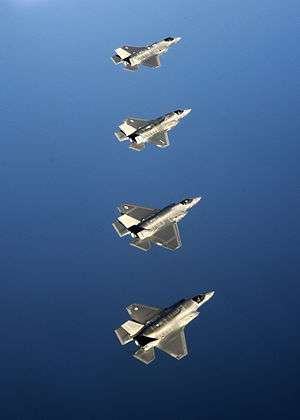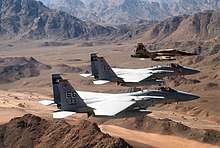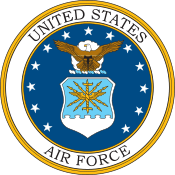33rd Fighter Wing
The 33rd Fighter Wing, sometimes written 33d Fighter Wing, (33 FW) is a United States Air Force unit assigned to Air Education and Training Command's Nineteenth Air Force. It is stationed at Eglin Air Force Base, Florida where it is a tenant unit.
| 33rd Fighter Wing | |
|---|---|
 | |
| Active | 1947–1952; 1956–1957; 1965–present |
| Country | United States |
| Branch | Air Force |
| Part of | Air Education and Training Command |
| Garrison/HQ | Eglin Air Force Base |
| Nickname(s) | Nomads |
| Motto(s) | Fire From the Clouds[1] |
| Engagements | Southwest Asia[1] |
| Decorations | Air Force Outstanding Unit Award[1] |
| Commanders | |
| Current commander | Colonel Jon S. Wheeler Jr. |
| Notable commanders | Carrol Chandler John P. Jumper William R. Looney III Gregory S. Martin[1] |
| Insignia | |
| 33rd Fighter Wing emblem (approved 5 October 1965)[1] |  |
The 33 FW is an AETC training unit. Its main mission is to train United States Air Force, United States Marine Corps, and United States Navy pilots and maintainers on the Lockheed Martin F-35 Lightning II. The wing will reach full strength in 2014, with more than 2,000 military personnel and 260 contractors. Annual capacity is planned for 2,150 pilot and maintenance students. A minimum of 59 F-35A, F-35B, and F-35C aircraft supporting Air Force training in the F-35A, Marine training in the F-35B, and Navy and Marine training in the F-35C, as well as international partner training in the various versions of the aircraft.
The 33rd Fighter Wing, known as the "Nomads" for its constant travel throughout the world, has a long, distinguished history. The unit was first activated at Roswell Army Air Field, New Mexico on 15 October 1947, but is entitled, by temporary bestowal, to the honors earned of the 33rd Pursuit Group that served in multiple theaters during World War II. Throughout the years, the wing has participated in numerous operations worldwide. Beginning in 1979, the wing began operating the McDonnell Douglas F-15 Eagle. In the 1980s, the unit took part in Operation Urgent Fury, the rescue of American medical students from Grenada. In the 1990s, the wing joined coalition forces for Operations Desert Shield and Desert Storm, scoring 16 aerial kills, the most of any single unit.
Following the 11 September 2001 attacks, the Nomads provided armed over-watch throughout North America for Operation Noble Eagle, securing two presidents of the United States, multiple space shuttle launches and other high-visibility events. The 33rd Fighter Wing closed its operations with the F-15 Eagle in September 2009 and became the Department of Defense's first F-35 Lightning II training wing on 1 October 2009.
Subordinate organizations
The wing operates one flying squadron, the 58th Fighter Squadron along with the 33rd Operations Support Squadron, the 33rd Maintenance Operations Squadron, the 33rd Aircraft Maintenance Squadron, the 33rd Maintenance Squadron and the 728th Air Control Squadron.
- 33rd Operations Group
- 58th Fighter Squadron
- 728th Air Control Squadron
- 337th Air Control Squadron, located at Tyndall Air Force Base
- 33rd Operations Support Squadron
- 33rd Maintenance Group
- 33rd Aircraft Maintenance Squadron
- 33rd Maintenance Operations Squadron
- 33rd Maintenance Squadron
History
- See 33rd Operations Group for related lineage and history.
Air Defense
The headquarters of the 33rd Fighter Wing became operational upon movement to Otis Air Force Base, Massachusetts, in mid-November 1948. The wing trained to maintain tactical proficiency and participated in exercises and aerial demonstrations from November 1948 to November 1949. It assumed an air defense mission in December 1949 and provided air defense in the northeastern United States until inactivated in February 1952, when it was inactivated and most personnel were transferred to the 4707th Air Defense Wing. Once again it provided air defense in the northeastern United States, from October 1956 to June 1957, but was non-operational from 1 July 1957 to 18 August 1957.
Tactical fighter operations
On 1 April 1965, the wing was activated at Eglin Air Force Base, Florida and embarked on a program of tactical training operations to maintain proficiency. It operated a test support division, from July 1965 to December 1967, and a special test squadron, from December 1967 to April 1971, in support of tests for weapon systems, aircraft armament and munitions, and tactical procedures of the Tactical Air Warfare Center. The first Tactical Air Command McDonnell F-4D Phantom IIs assigned to a combat unit arrived at the 33rd at Eglin on 21 June 1966.[2] The wing also provided F-4 replacement training from 15 December 1966 to 28 February 1967. Through deployment of combat-ready tactical components, with personnel and equipment transferred to Pacific Air Forces (PACAF) units upon arrival, the wing provided fresh aircraft and aircrews for the forces in Southeast Asia and in Korea. The wing also transferred two of its combat-ready squadrons to PACAF, the 25th Tactical Fighter Squadron in May 1968 and the 4th Tactical Fighter Squadron in April 1969. The wing's last combat-ready squadron, the 58th Tactical Fighter Squadron, deployed to Southeast Asia for combat operations from April to October 1972 and again from June to September 1973.
The wing supported the 4485th Test Squadron of the Tactical Air Warfare Center in weapon systems evaluation program tests from January to December 1973, and periodically thereafter until July 1978. Aircrews ferried F-4Es to Israel in October 1973. The wing augmented intercept defense forces of the North American Air Defense Command (NORAD) from 1 January 1976 to 15 January 1979 and from 4 January 1982 to 5 April 1982. While awaiting delivery of McDonnell Douglas F-15 Eagles, the 60th Fighter Squadron conducted F-15 mission qualifications training for the 18th Tactical Fighter Wing (Kadena Air Base, Japan) from 15 July 1979 to 30 April 1980. The wing provided personnel and equipment to fly combat air patrols and air intercept missions for contingency operations in Grenada, from October to November 1983, and Panama, from December 1989 to January 1990.
Recent operations

During combat operations while deployed in Southwest Asia from 26 August 1990 to 12 April 1991, 33 FW personnel were credited with sixteen air-to-air victories. Wing personnel and aircraft continued rotations to Saudi Arabia to protect coalition assets and to ensure that Iraq complied with treaty terms.
From 1992 to 2002 the 33rd Operations Group continued to deploy aircraft and personnel to Saudi Arabia, Canada, the Caribbean, South America, Jamaica, Iceland, Italy, and Puerto Rico and participated in various operations. Twelve of the 19 airmen killed in the Khobar Towers bombing in Saudi Arabia on 25 June 1996 were members of the 33rd Wing.[3]
The 33rd Fighter Wing divested itself of its F-15C and F-15D Eagle aircraft in 2008 and 2009 and completed the transition from Air Combat Command (ACC) to Air Education and Training Command (AETC) on 1 October 2009. At the same time, it became the first American F-35 Lightning II training unit.
On 13 January 2011, the 33rd Fighter Wing received four General Dynamics F-16s from the 56th Fighter Wing at Luke AFB, Arizona. The jets will help establish a "battle rhythm," as the wing stands up the first Joint Training Center for the fifth generation F-35 Joint Strike Fighter.[4] In July 2011, the wing received its first two F-35A Lightning II aircraft.
Lineage
- Established as the 33rd Fighter Wing on 15 October 1947
- Organized on 5 November 1947
- Redesignated 33rd Fighter-Interceptor Wing on 20 January 1950
- Inactivated on 6 February 1952
- Redesignated 33rd Fighter Wing (Air Defense) on 14 September 1956
- Activated on 18 October 1956
- Inactivated on 18 August 1957
- Redesignated 33rd Tactical Fighter Wing and activated on 9 February 1965 (not organized)
- Organized on 1 April 1965
- Redesignated 33rd Fighter Wing on 1 October 1991[1]
Assignments
|
|
Stations
- Roswell Army Air Field (later Walker Air Force Base), New Mexico, 5 November 1947
- Otis Air Force Base, Massachusetts, 16 November 1948 – 6 February 1952
- Otis Air Force Base, Massachusetts, 18 October 1956 – 18 August 1957
- Eglin Air Force Base, Florida, 1 April 1965 – present[1]
Components
Wing
- 50th Fighter (later, 50th Fighter-Interceptor): attached 1 June 1949 – 2 June 1951[1]
Group
- 33rd Fighter Group (later 33rd Fighter-Interceptor Group, 33rd Fighter Group, 33rd Operations Group): 5 November 1947 – 6 February 1952 (detached until 15 November 1948), 18 October 1956 – 18 August 1957 (detached after 1 July 1957); 1 December 1991 – present[1]
Squadron
- 4th Tactical Fighter Squadron: 20 June 1965 – 12 April 1969
- 16th Tactical Fighter Squadron: 20 June 1965 – 1 November 1970 (detached 27 August – 13 September 1966, 13–31 October 1967, 26 May – 9 September 1970)
- 25th Tactical Fighter Squadron: 20 June 1965 – 28 May 1968
- 40th Tactical Fighter Squadron: 20 June 1965 – 15 October 1970
- 58th Tactical Fighter Squadron: 1 September 1970 – 1 December 1991 (detached 29 April – 14 October 1972, 8 June – 14 September 1973, 8–22 August 1975, 31 January – 14 February 1977; 28 August 1990 – 1 December 1991)
- 59th Tactical Fighter Squadron (later 59th Fighter Squadron): 1 September 1970 – 1 December 1991 (detached 24–29 March 1974)
- 60th Tactical Fighter Squadron (later 60th Fighter Squadron): 1 September 1971 – 1 December 1991
- 133rd Fighter-Interceptor Squadron: attached 21 July 1951 – 6 February 1952
- 786th Tactical Fighter Squadron: 1 April – 20 June 1965
- 787th Tactical Fighter Squadron: 1 April – 20 June 1965
- 788th Tactical Fighter Squadron: 1 April – 20 June 1965
- 789th Tactical Fighter Squadron: 1 April – 20 June 1965
- 4533rd Tactical Training Squadron (Test): 7 December 1967 – 12 April 1971[1]
Aircraft
- North American F-51 Mustang (1948–1950)
- Republic F-84 Thunderjet (1948–1950)
- North American F-86 Sabre (1950–1952)
- Lockheed F-94 Starfire (1951–1952, 1956–1957)
- Republic F-47 Thunderbolt (1951–1952)
- Northrop F-89 Scorpion (1956–1957)
- McDonnell F-4 Phantom II (1965–1979)
- McDonnell Douglas F-15 Eagle (1978–2009)
- Lockheed Martin F-35 Lightning II (2010–present)
- F-16 Fighting Falcon (2011–2011)[1]
See also
References
Notes
- Bailey, Carl E. (28 November 2007). "Factsheet 33 Fighter Wing (ACC)". Air Force Historical Research Agency. Retrieved 13 February 2017.
- Knaack, p. 274.
- Foster, pp. 27–28
- Wright, Ashley M. (14 January 2011). "F-16s' arrival brings 'battle rhythm' to JSF wing". 96 Air Base Wing Public Affairs. Archived from the original on 4 March 2016. Retrieved 13 February 2017.
Bibliography
![]()
- Foster, Jr., Charles B. (2012). 33d Fighter Wing Heritage Pamphlet (PDF). Eglin Air Force Base, FL: 33d Fighter Wing Public Affairs. Archived from the original (PDF) on 18 February 2013. Retrieved 23 December 2014.
- Knaack, Marcelle Size. Encyclopedia of US Air Force Aircraft and Missile Systems, Volume 1, Post-World War Two Fighters, 1945–1973. Washington, DC: Office of Air Force History, 1978. ISBN 0-912799-59-5
- Maurer, Maurer, ed. (1983) [1961]. Air Force Combat Units of World War II (PDF) (reprint ed.). Washington, DC: Office of Air Force History. ISBN 0-912799-02-1. LCCN 61060979.
- Ravenstein, Charles A. Air Force Combat Wings, Lineage & Honors Histories 1947–1977. Washington, DC: Office of Air Force History. ISBN 0-912799-12-9.
- Rogers, Brian. (2005). United States Air Force Unit Designations Since 1978. Hinkley, UK: Midland Publications. ISBN 1-85780-197-0.
External links
- "Factsheets: 33rd Fighter Wing". United States Air Force. Archived from the original on 27 December 2010. Retrieved 6 January 2010.
- 33rd Fighter Wing Home Page


